MyBatis是常见的Java数据库访问层框架。开发人员多数情况下是使用MyBatis的默认缓存配置,但是MyBatis缓存机制有一些不足之处,在使用中容易引起脏数据,形成一些潜在的隐患。个人在业务开发中也处理过一些由于MyBatis缓存引发的开发问题,希望从应用及源码的角度为读者梳理MyBatis缓存机制。
# 一、一级缓存
在应用运行过程中,我们有可能在一次数据库会话中,执行多次查询条件完全相同的SQL,MyBatis提供了一级缓存的方案优化这部分场景,如果是相同的SQL语句,会优先命中一级缓存,避免直接对数据库进行查询,提高性能。具体执行过程如下图所示。
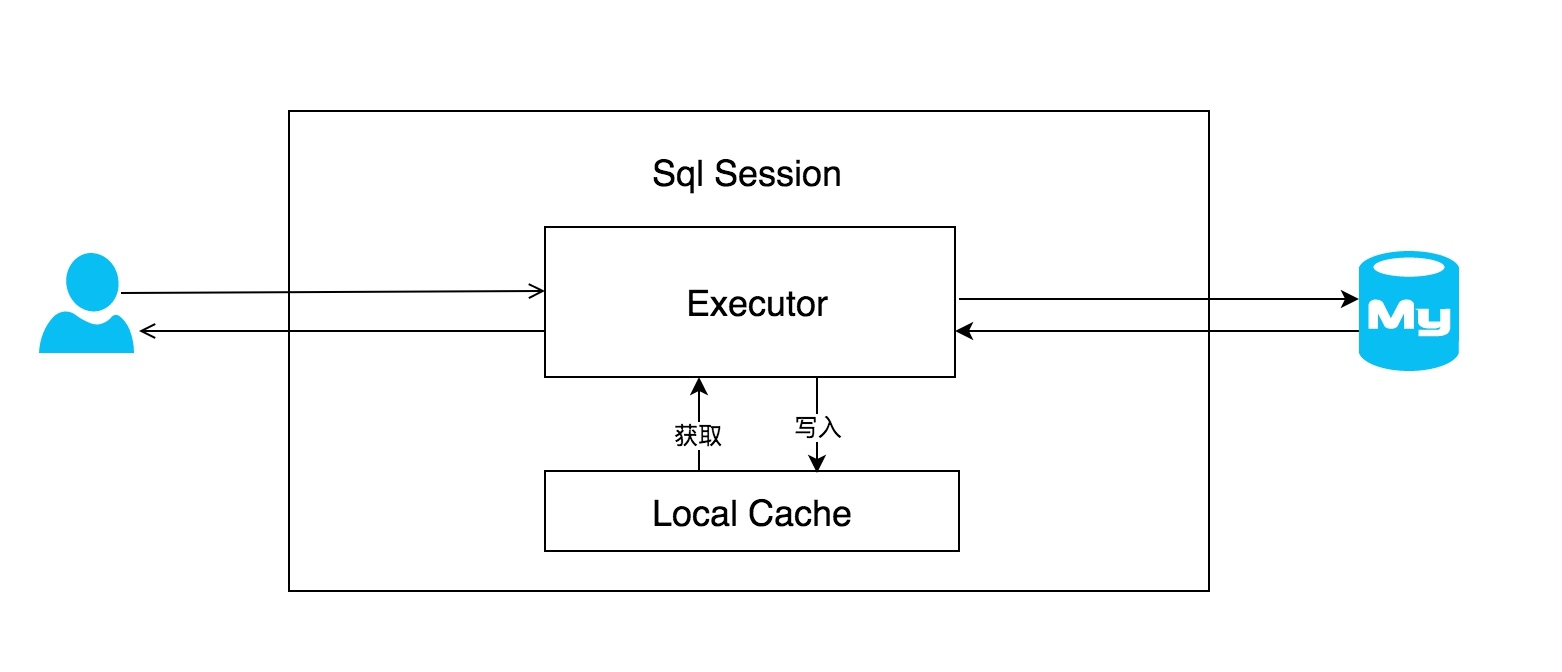
每个SqlSession中持有了Executor,每个Executor中有一个LocalCache。当用户发起查询时,MyBatis根据当前执行的语句生成MappedStatement,在Local Cache进行查询,如果缓存命中的话,直接返回结果给用户,如果缓存没有命中的话,查询数据库,结果写入Local Cache,最后返回结果给用户。具体实现类的类关系图如下图所示。
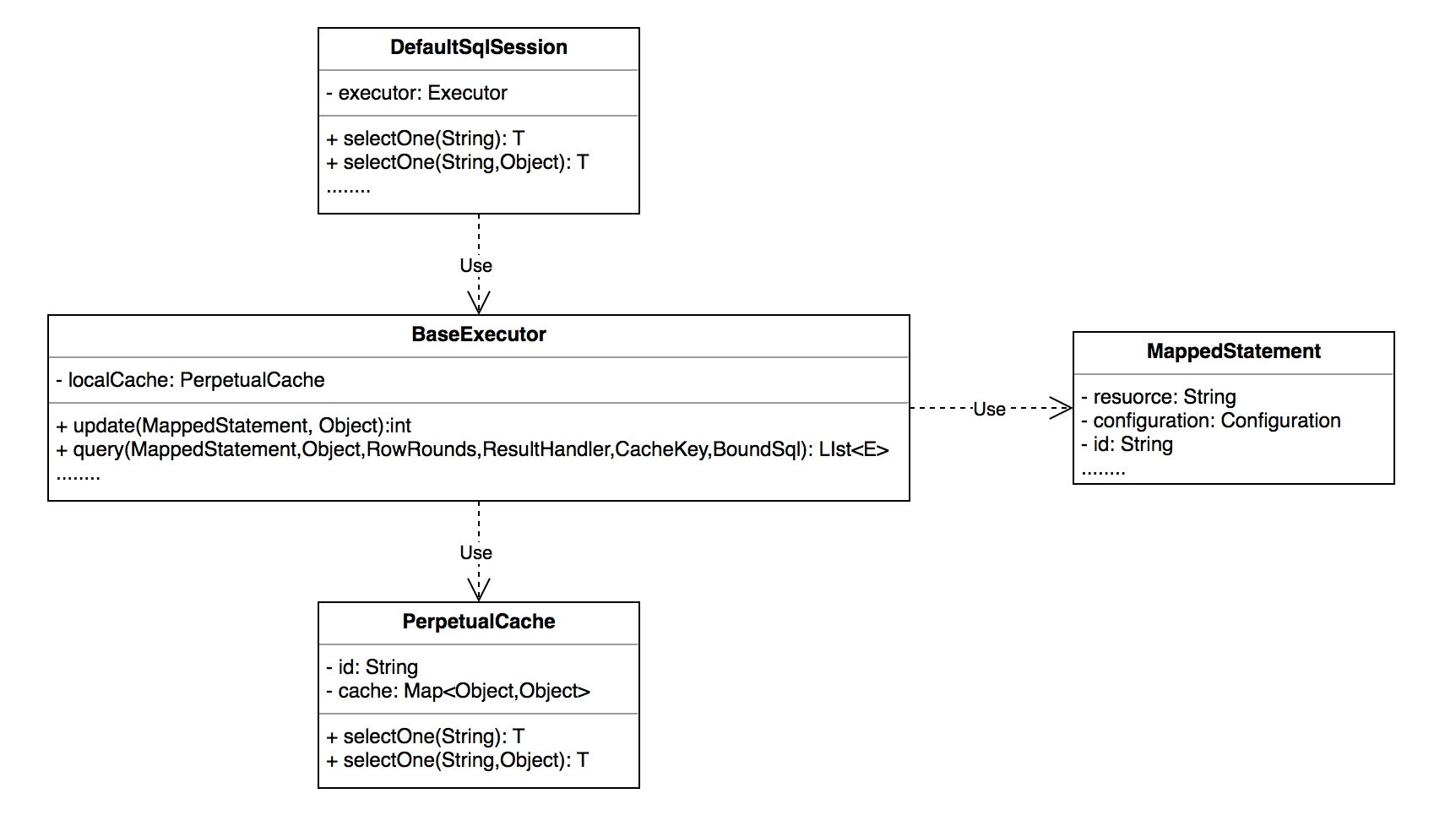
一级缓存配置:我们来看看如何使用MyBatis一级缓存。开发者只需在MyBatis的配置文件中,添加如下语句,就可以使用一级缓存。共有两个选项,SESSION或者STATEMENT,默认是SESSION级别,即在一个MyBatis会话中执行的所有语句,都会共享这一个缓存。一种是STATEMENT级别,可以理解为缓存只对当前执行的这一个Statement有效。
<setting name="localCacheScope" value="SESSION"/>
接下来通过实验,了解MyBatis一级缓存的效果,每个单元测试后都请恢复被修改的数据。首先是创建示例表student,创建对应的POJO类和增改的方法,具体可以在entity包和mapper包中查看。
CREATE TABLE `student` (
`id` int(11) unsigned NOT NULL AUTO_INCREMENT,
`name` varchar(200) COLLATE utf8_bin DEFAULT NULL,
`age` tinyint(3) unsigned DEFAULT NULL,
PRIMARY KEY (`id`)
) ENGINE=InnoDB AUTO_INCREMENT=4 DEFAULT CHARSET=utf8 COLLATE=utf8_bin;
2
3
4
5
6
在以下实验中,id为1的学生名称是凯伦。
# 实验1
开启一级缓存,范围为会话级别,调用三次getStudentById,代码如下所示:
public void getStudentById() throws Exception {
SqlSession sqlSession = factory.openSession(true); // 自动提交事务
StudentMapper studentMapper = sqlSession.getMapper(StudentMapper.class);
System.out.println(studentMapper.getStudentById(1));
System.out.println(studentMapper.getStudentById(1));
System.out.println(studentMapper.getStudentById(1));
}
2
3
4
5
6
7
执行结果:我们可以看到,只有第一次真正查询了数据库,后续的查询使用了一级缓存。
DEBUG [main] - ==> Preparing: SELECT id,name,age FROM student WHERE id = ?
DEBUG [main] - ==> Parameters: 1(Integer)
TRACE [main] - <== Columns: id, name, age
TRACE [main] - <== Row: 1, 凯伦, 25
DEBUG [main] - <== Total: 1
StudentEntity{id=1, name='凯伦', age=25}
StudentEntity{id=1, name='凯伦', age=25}
StudentEntity{id=1, name='凯伦', age=25}
2
3
4
5
6
7
8
# 实验2
增加了对数据库的修改操作,验证在一次数据库会话中,如果对数据库发生了修改操作,一级缓存是否会失效。
@Test
public void addStudent() throws Exception {
SqlSession sqlSession = factory.openSession(true); // 自动提交事务
StudentMapper studentMapper = sqlSession.getMapper(StudentMapper.class);
System.out.println(studentMapper.getStudentById(1));
System.out.println("增加" + studentMapper.addStudent(buildStudent()) + "名学生");
System.out.println(studentMapper.getStudentById(1));
sqlSession.close();
}
2
3
4
5
6
7
8
9
执行结果:我们可以看到,在修改操作后执行的相同查询,查询了数据库,一级缓存失效。
DEBUG [main] - ==> Preparing: SELECT id,name,age FROM student WHERE id = ?
DEBUG [main] - ==> Parameters: 1(Integer)
TRACE [main] - <== Columns: id, name, age
TRACE [main] - <== Row: 1, 凯伦, 25
DEBUG [main] - <== Total: 1
StudentEntity{id=1, name='凯伦', age=25}
DEBUG [main] - ==> Preparing: INSERT INTO student(name,age) VALUES(?,?)
DEBUG [main] - ==> Parameters: 小康(String), 22(Integer)
DEBUG [main] - <== Updates: 1
添加1名学生
DEBUG [main] - ==> Preparing: SELECT id,name,age FROM student WHERE id = ?
DEBUG [main] - ==> Parameters: 1(Integer)
TRACE [main] - <== Columns: id, name, age
TRACE [main] - <== Row: 1, 凯伦, 25
DEBUG [main] - <== Total: 1
2
3
4
5
6
7
8
9
10
11
12
13
14
15
# 实验3
开启两个SqlSession,在sqlSession1中查询数据,使一级缓存生效,在sqlSession2中更新数据库,验证一级缓存只在数据库会话内部共享。
@Test
public void testLocalCacheScope() throws Exception {
SqlSession sqlSession1 = factory.openSession(true);
SqlSession sqlSession2 = factory.openSession(true);
StudentMapper studentMapper = sqlSession1.getMapper(StudentMapper.class);
StudentMapper studentMapper2 = sqlSession2.getMapper(StudentMapper.class);
System.out.println(studentMapper.getStudentById(1));
System.out.println("更新了" + studentMapper2.updateStudentName("小明",1) + "名学生的数据");
System.out.println(studentMapper.getStudentById(1));
System.out.println(studentMapper2.getStudentById(1));
}
2
3
4
5
6
7
8
9
10
11
12
13
sqlSession2更新了id为1的学生的姓名,从凯伦改为了小明,但session1之后的查询中,id为1的学生的名字还是凯伦,出现了脏数据,也证明了之前的设想,一级缓存只在数据库会话内部共享。
DEBUG [main] - ==> Preparing: SELECT id,name,age FROM student WHERE id = ?
DEBUG [main] - ==> Parameters: 1(Integer)
TRACE [main] - <== Columns: id, name, age
TRACE [main] - <== Row: 1, 凯伦, 25
DEBUG [main] - <== Total: 1
StudentEntity{id=1, name='凯伦', age=25}
DEBUG [main] - ==> Preparing: INSERT INTO student(name,age) VALUES(?,?)
DEBUG [main] - ==> Parameters: 小明(String), 21(Integer)
DEBUG [main] - <== Updates: 1
更新了1名学生的数据 --SqlSession2更新了数据
StudentEntity{id=1, name='凯伦', age=25} --SqlSession1读到了脏数据
DEBUG [main] - ==> Preparing: SELECT id,name,age FROM student WHERE id = ?
DEBUG [main] - ==> Parameters: 1(Integer)
TRACE [main] - <== Columns: id, name, age
TRACE [main] - <== Row: 1, 小明, 21
DEBUG [main] - <== Total: 1
StudentEntity{id=1, name='小明', age=21}
2
3
4
5
6
7
8
9
10
11
12
13
14
15
16
17
# 二、一级缓存工作流程
工作流程:一级缓存执行的时序图,如下图所示。
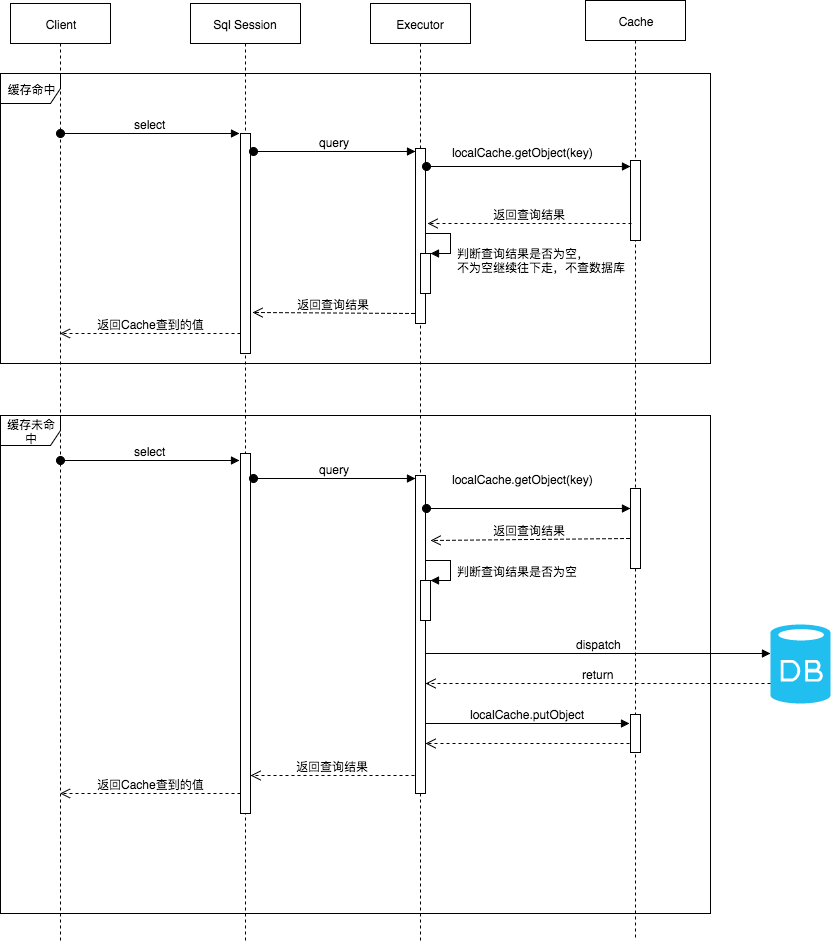
# 三、源码分析
接下来将对
MyBatis查询相关的核心类和一级缓存的源码进行解读。这对后面学习二级缓存也有帮助。
SqlSession: 对外提供了用户和数据库之间交互需要的所有方法,隐藏了底层的细节。默认实现类是DefaultSqlSession。
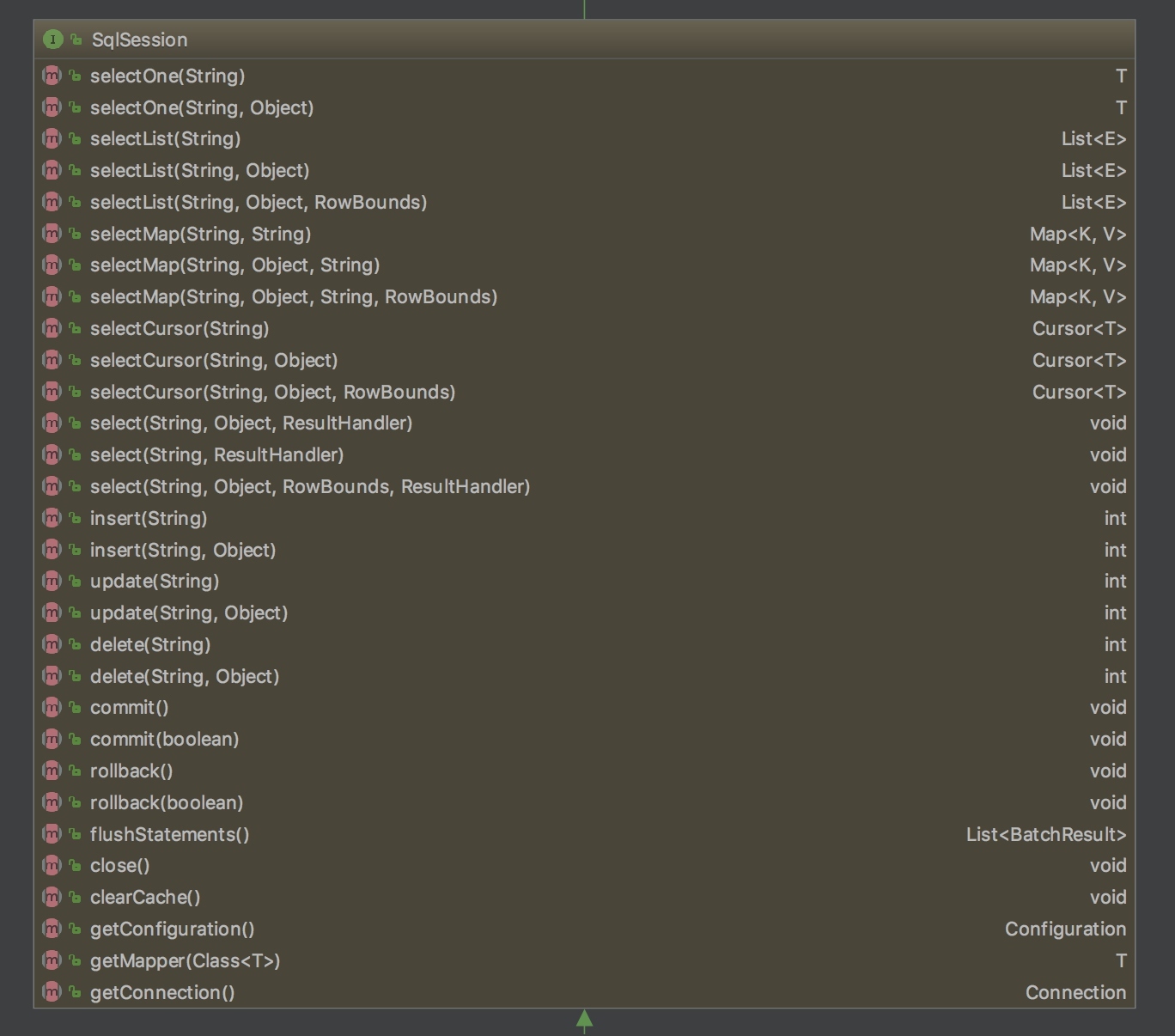
Executor: SqlSession向用户提供操作数据库的方法,但和数据库操作有关的职责都会委托给Executor。
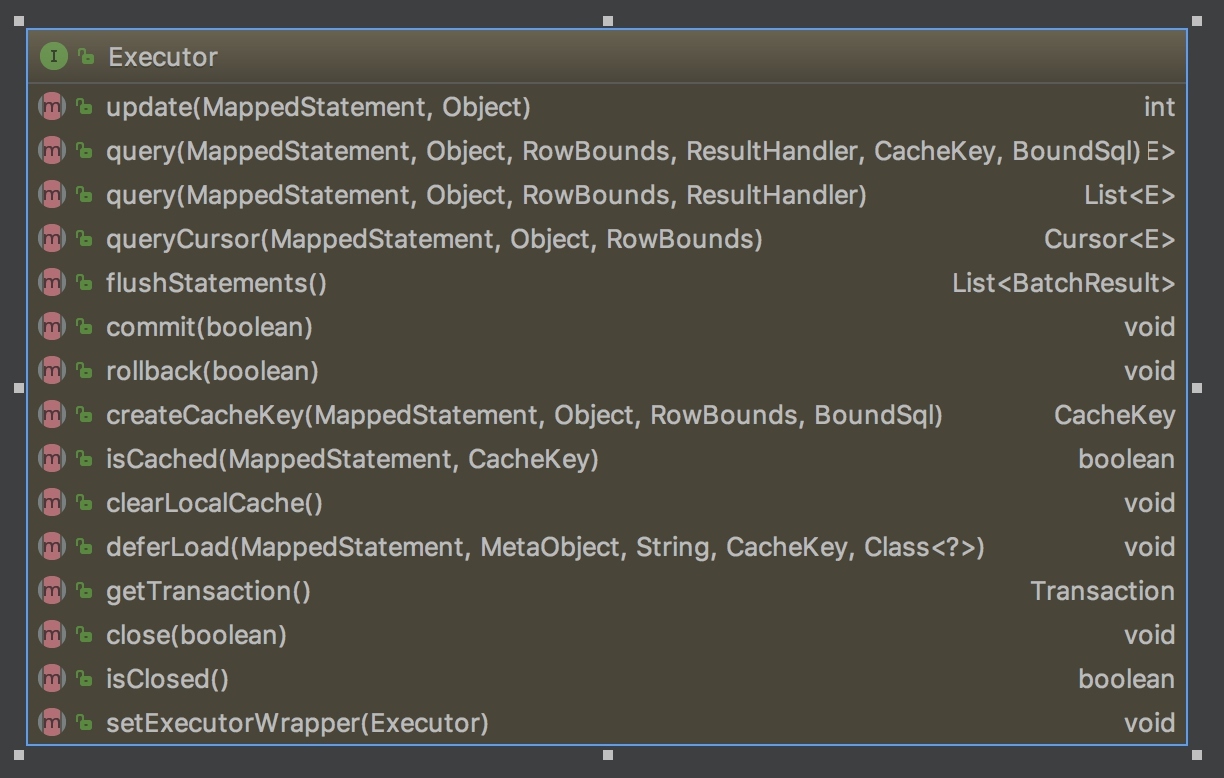
如下图所示,Executor有若干个实现类,为Executor赋予了不同的能力,大家可以根据类名,自行学习每个类的基本作用。

在一级缓存的源码分析中,主要学习BaseExecutor的内部实现。
BaseExecutor: BaseExecutor是一个实现了Executor接口的抽象类,定义若干抽象方法,在执行的时候,把具体的操作委托给子类进行执行。
protected abstract int doUpdate(MappedStatement ms, Object parameter) throws SQLException;
protected abstract List<BatchResult> doFlushStatements(boolean isRollback) throws SQLException;
protected abstract <E> List<E> doQuery(MappedStatement ms, Object parameter, RowBounds rowBounds, ResultHandler resultHandler, BoundSql boundSql) throws SQLException;
protected abstract <E> Cursor<E> doQueryCursor(MappedStatement ms, Object parameter, RowBounds rowBounds, BoundSql boundSql) throws SQLException;
2
3
4
在一级缓存的介绍中提到对Local Cache的查询和写入是在Executor内部完成的。在阅读BaseExecutor的代码后发现Local Cache是BaseExecutor内部的一个成员变量,如下代码所示。
public abstract class BaseExecutor implements Executor {
protected ConcurrentLinkedQueue<DeferredLoad> deferredLoads;
protected PerpetualCache localCache;
2
3
Cache: MyBatis中的Cache接口,提供了和缓存相关的最基本的操作,如下所示:
getId() String
putObject(Object, Object) void
getObject(Object) Object
removeObject(Object) Object
clear() void
getSize() int
getReadWriteLock() ReadWriteLock
2
3
4
5
6
7

有若干个实现类,使用装饰器模式互相组装,提供丰富的操控缓存的能力,部分实现类如下图所示:
BaseExecutor成员变量之一的PerpetualCache,是对Cache接口最基本的实现,其实现非常简单,内部持有HashMap,对一级缓存的操作实则是对HashMap的操作。如下代码所示:
public class PerpetualCache implements Cache {
private String id;
private Map<Object, Object> cache = new HashMap<Object, Object>();
2
3
在阅读相关核心类代码后,从源代码层面对一级缓存工作中涉及到的相关代码,出于篇幅的考虑,对源码做适当删减,读者朋友可以结合本文,后续进行更详细的学习。
为执行和数据库的交互,首先需要初始化SqlSession,通过DefaultSqlSessionFactory开启SqlSession:
private SqlSession openSessionFromDataSource(ExecutorType execType, TransactionIsolationLevel level, boolean autoCommit) {
............
final Executor executor = configuration.newExecutor(tx, execType);
return new DefaultSqlSession(configuration, executor, autoCommit);
}
2
3
4
5
在初始化SqlSesion时,会使用Configuration类创建一个全新的Executor,作为DefaultSqlSession构造函数的参数,创建Executor代码如下所示:
public Executor newExecutor(Transaction transaction, ExecutorType executorType) {
executorType = executorType == null ? defaultExecutorType : executorType;
executorType = executorType == null ? ExecutorType.SIMPLE : executorType;
Executor executor;
if (ExecutorType.BATCH == executorType) {
executor = new BatchExecutor(this, transaction);
} else if (ExecutorType.REUSE == executorType) {
executor = new ReuseExecutor(this, transaction);
} else {
executor = new SimpleExecutor(this, transaction);
}
// 尤其可以注意这里,如果二级缓存开关开启的话,是使用CahingExecutor装饰BaseExecutor的子类
if (cacheEnabled) {
executor = new CachingExecutor(executor);
}
executor = (Executor) interceptorChain.pluginAll(executor);
return executor;
}
2
3
4
5
6
7
8
9
10
11
12
13
14
15
16
17
18
SqlSession创建完毕后,根据Statment的不同类型,会进入SqlSession的不同方法中,如果是Select语句的话,最后会执行到SqlSession的selectList,代码如下所示:
@Override
public <E> List<E> selectList(String statement, Object parameter, RowBounds rowBounds) {
MappedStatement ms = configuration.getMappedStatement(statement);
return executor.query(ms, wrapCollection(parameter), rowBounds, Executor.NO_RESULT_HANDLER);
}
2
3
4
5
SqlSession把具体的查询职责委托给了Executor。如果只开启了一级缓存的话,首先会进入BaseExecutor的query方法。代码如下所示:
@Override
public <E> List<E> query(MappedStatement ms, Object parameter, RowBounds rowBounds, ResultHandler resultHandler) throws SQLException {
BoundSql boundSql = ms.getBoundSql(parameter);
CacheKey key = createCacheKey(ms, parameter, rowBounds, boundSql);
return query(ms, parameter, rowBounds, resultHandler, key, boundSql);
}
2
3
4
5
6
在上述代码中,会先根据传入的参数生成CacheKey,进入该方法查看CacheKey是如何生成的,代码如下所示:
CacheKey cacheKey = new CacheKey();
cacheKey.update(ms.getId());
cacheKey.update(rowBounds.getOffset());
cacheKey.update(rowBounds.getLimit());
cacheKey.update(boundSql.getSql());
//后面是update了sql中带的参数
cacheKey.update(value);
2
3
4
5
6
7
在上述的代码中,将MappedStatement的Id、SQL的offset、SQL的limit、SQL本身以及SQL中的参数传入了CacheKey这个类,最终构成CacheKey。以下是这个类的内部结构:
private static final int DEFAULT_MULTIPLYER = 37;
private static final int DEFAULT_HASHCODE = 17;
private int multiplier;
private int hashcode;
private long checksum;
private int count;
private List<Object> updateList;
public CacheKey() {
this.hashcode = DEFAULT_HASHCODE;
this.multiplier = DEFAULT_MULTIPLYER;
this.count = 0;
this.updateList = new ArrayList<Object>();
}
2
3
4
5
6
7
8
9
10
11
12
13
14
15
首先是成员变量和构造函数,有一个初始的hachcode和乘数,同时维护了一个内部的updatelist。在CacheKey的update方法中,会进行一个hashcode和checksum的计算,同时把传入的参数添加进updatelist中。如下代码所示:
public void update(Object object) {
int baseHashCode = object == null ? 1 : ArrayUtil.hashCode(object);
count++;
checksum += baseHashCode;
baseHashCode *= count;
hashcode = multiplier * hashcode + baseHashCode;
updateList.add(object);
}
2
3
4
5
6
7
8
9
同时重写了CacheKey的equals方法,代码如下所示:
@Override
public boolean equals(Object object) {
.............
for (int i = 0; i < updateList.size(); i++) {
Object thisObject = updateList.get(i);
Object thatObject = cacheKey.updateList.get(i);
if (!ArrayUtil.equals(thisObject, thatObject)) {
return false;
}
}
return true;
}
2
3
4
5
6
7
8
9
10
11
12
除去hashcode、checksum和count的比较外,只要updatelist中的元素一一对应相等,那么就可以认为是CacheKey相等。只要两条SQL的下列五个值相同,即可以认为是相同的SQL。
Statement Id + Offset + Limmit + Sql + Params
BaseExecutor的query方法继续往下走,代码如下所示:
list = resultHandler == null ? (List<E>) localCache.getObject(key) : null;
if (list != null) {
// 这个主要是处理存储过程用的。
handleLocallyCachedOutputParameters(ms, key, parameter, boundSql);
} else {
list = queryFromDatabase(ms, parameter, rowBounds, resultHandler, key, boundSql);
}
2
3
4
5
6
7
如果查不到的话,就从数据库查,在queryFromDatabase中,会对localcache进行写入。
在query方法执行的最后,会判断一级缓存级别是否是STATEMENT级别,如果是的话,就清空缓存,这也就是STATEMENT级别的一级缓存无法共享localCache的原因。代码如下所示:
if (configuration.getLocalCacheScope() == LocalCacheScope.STATEMENT) {
clearLocalCache();
}
2
3
在源码分析的最后,我们确认一下,如果是insert/delete/update方法,缓存就会刷新的原因。
SqlSession的insert方法和delete方法,都会统一走update的流程,代码如下所示:
@Override
public int insert(String statement, Object parameter) {
return update(statement, parameter);
}
@Override
public int delete(String statement) {
return update(statement, null);
}
2
3
4
5
6
7
8
update方法也是委托给了Executor执行。BaseExecutor的执行方法如下所示:
@Override
public int update(MappedStatement ms, Object parameter) throws SQLException {
ErrorContext.instance().resource(ms.getResource()).activity("executing an update").object(ms.getId());
if (closed) {
throw new ExecutorException("Executor was closed.");
}
clearLocalCache();
return doUpdate(ms, parameter);
}
2
3
4
5
6
7
8
9
每次执行update前都会清空localCache。至此,一级缓存的工作流程讲解以及源码分析完毕。
WARNING
MyBatis一级缓存的生命周期和SqlSession一致。
MyBatis一级缓存内部设计简单,只是一个没有容量限定的HashMap,在缓存的功能性上有所欠缺。
MyBatis的一级缓存最大范围是SqlSession内部,有多个SqlSession或者分布式的环境下,数据库写操作会引起脏数据,建议设定缓存级别为Statement。
# 四、二级缓存
在一级缓存中,其最大的共享范围就是一个SqlSession内部,如果多个SqlSession之间需要共享缓存,则需要使用到二级缓存。开启二级缓存后,会使用CachingExecutor装饰Executor,进入一级缓存的查询流程前,先在CachingExecutor进行二级缓存的查询,具体的工作流程如下所示。
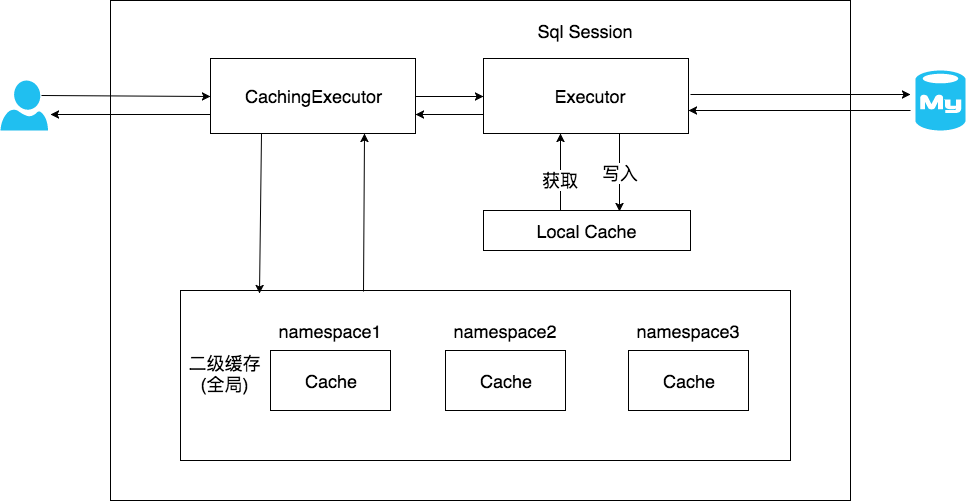
二级缓存开启后,同一个namespace下的所有操作语句,都影响着同一个Cache,即二级缓存被多个SqlSession共享,是一个全局的变量。
当开启缓存后,数据的查询执行的流程就是 二级缓存 -> 一级缓存 -> 数据库。
二级缓存配置: 要正确的使用二级缓存,需完成如下配置的。
【1】在MyBatis的配置文件中开启二级缓存。
<setting name="cacheEnabled" value="true"/>
【2】在MyBatis的映射XML中配置cache或者cache-ref。cache标签用于声明这个namespace使用二级缓存,并且可以自定义配置。
<cache/>
type:cache使用的类型,默认是PerpetualCache,这在一级缓存中提到过。
eviction: 定义回收的策略,常见的有FIFO,LRU。
flushInterval: 配置一定时间自动刷新缓存,单位是毫秒。
size: 最多缓存对象的个数。
readOnly: 是否只读,若配置可读写,则需要对应的实体类能够序列化。
blocking: 若缓存中找不到对应的key,是否会一直blocking,直到有对应的数据进入缓存。
2
3
4
5
6
cache-ref代表引用别的命名空间的Cache配置,两个命名空间的操作使用的是同一个Cache。
<cache-ref namespace="mapper.StudentMapper"/>
二级缓存实验:接下来我们通过实验,了解MyBatis二级缓存在使用上的一些特点。在本实验中,id为1的学生名称初始化为海伦。
# 实验1
测试二级缓存效果,不提交事务,sqlSession1查询完数据后,sqlSession2相同的查询是否会从缓存中获取数据。
@Test
public void testCacheWithoutCommitOrClose() throws Exception {
SqlSession sqlSession1 = factory.openSession(true);
SqlSession sqlSession2 = factory.openSession(true);
StudentMapper studentMapper = sqlSession1.getMapper(StudentMapper.class);
StudentMapper studentMapper2 = sqlSession2.getMapper(StudentMapper.class);
System.out.println(studentMapper.getStudentById(1));
System.out.println(studentMapper2.getStudentById(1));
}
2
3
4
5
6
7
8
9
10
11
执行结果:当sqlsession没有调用commit()方法时,二级缓存并没有起到作用。
DEBUG [main] - Cache Hit Ratio [mapper.StudentMapper]: 0.0
DEBUG [main] - ==> Preparing: SELECT id,name,age FROM student WHERE id = ?
DEBUG [main] - ==> Parameters: 1(Integer)
TRACE [main] - <== Columns: id, name, age
TRACE [main] - <== Row: 1, 凯伦, 25
DEBUG [main] - <== Total: 1
StudentEntity{id=1, name='凯伦', age=25}
DEBUG [main] - Cache Hit Ratio [mapper.StudentMapper]: 0.0
DEBUG [main] - ==> Preparing: SELECT id,name,age FROM student WHERE id = ?
DEBUG [main] - ==> Parameters: 1(Integer)
TRACE [main] - <== Columns: id, name, age
TRACE [main] - <== Row: 1, 凯伦, 25
DEBUG [main] - <== Total: 1
StudentEntity{id=1, name='凯伦', age=25}
2
3
4
5
6
7
8
9
10
11
12
13
14
# 实验2
测试二级缓存效果,当提交事务时,sqlSession1查询完数据后,sqlSession2相同的查询是否会从缓存中获取数据。
@Test
public void testCacheWithCommitOrClose() throws Exception {
SqlSession sqlSession1 = factory.openSession(true);
SqlSession sqlSession2 = factory.openSession(true);
StudentMapper studentMapper = sqlSession1.getMapper(StudentMapper.class);
StudentMapper studentMapper2 = sqlSession2.getMapper(StudentMapper.class);
System.out.println(studentMapper.getStudentById(1));
sqlSession1.commit();
System.out.println(studentMapper2.getStudentById(1));
}
2
3
4
5
6
7
8
9
10
11
12
执行结果:sqlsession2的查询,使用了缓存,缓存的命中率是0.5。
DEBUG [main] - Cache Hit Ratio [mapper.StudentMapper]: 0.0
DEBUG [main] - ==> Preparing: SELECT id,name,age FROM student WHERE id = ?
DEBUG [main] - ==> Parameters: 1(Integer)
TRACE [main] - <== Columns: id, name, age
TRACE [main] - <== Row: 1, 凯伦, 25
DEBUG [main] - <== Total: 1
StudentEntity{id=1, name='凯伦', age=25}
DEBUG [main] - Cache Hit Ratio [mapper.StudentMapper]: 0.5
StudentEntity{id=1, name='凯伦', age=25}
2
3
4
5
6
7
8
9
# 实验3
测试update操作是否会刷新该namespace下的二级缓存。
@Test
public void testCacheWithUpdate() throws Exception {
SqlSession sqlSession1 = factory.openSession(true);
SqlSession sqlSession2 = factory.openSession(true);
SqlSession sqlSession3 = factory.openSession(true);
StudentMapper studentMapper = sqlSession1.getMapper(StudentMapper.class);
StudentMapper studentMapper2 = sqlSession2.getMapper(StudentMapper.class);
StudentMapper studentMapper3 = sqlSession3.getMapper(StudentMapper.class);
System.out.println(studentMapper.getStudentById(1));
sqlSession1.commit();
System.out.println(studentMapper2.getStudentById(1));
studentMapper3.updateStudentName("小伟",1);
sqlSession3.commit();
System.out.println(studentMapper2.getStudentById(1));
}
2
3
4
5
6
7
8
9
10
11
12
13
14
15
16
17
18
执行结果:在sqlSession3更新数据库,并提交事务后,sqlsession2的StudentMapper namespace下的查询走了数据库,没有走Cache。
DEBUG [main] - Cache Hit Ratio [mapper.StudentMapper]: 0.0
DEBUG [main] - ==> Preparing: SELECT id,name,age FROM student WHERE id = ?
DEBUG [main] - ==> Parameters: 1(Integer)
TRACE [main] - <== Columns: id, name, age
TRACE [main] - <== Row: 1, 凯伦, 25
DEBUG [main] - <== Total: 1
StudentEntity{id=1, name='凯伦', age=25}
DEBUG [main] - Cache Hit Ratio [mapper.StudentMapper]: 0.5
StudentEntity{id=1, name='凯伦', age=25}
DEBUG [main] - ==> Preparing: UPDATE student SET name = ? WHERE id = ?
DEBUG [main] - ==> Parameters: 小伟(String) 1(Integer)
DEBUG [main] - <== Updates: 1
DEBUG [main] - Cache Hit Ratio [mapper.StudentMapper]: 0.333333333333333
DEBUG [main] - ==> Preparing: SELECT id,name,age FROM student WHERE id = ?
DEBUG [main] - ==> Parameters: 1(Integer)
TRACE [main] - <== Columns: id, name, age
TRACE [main] - <== Row: 1, 小伟, 20
DEBUG [main] - <== Total: 1
StudentEntity{id=1, name='小伟', age=20}
2
3
4
5
6
7
8
9
10
11
12
13
14
15
16
17
18
19
# 实验4
验证MyBatis的二级缓存不适应用于映射文件中存在多表查询的情况。通常我们会为每个单表创建单独的映射文件,由于MyBatis的二级缓存是基于namespace的,多表查询语句所在的namspace无法感应到其他namespace中的语句对多表查询中涉及的表进行的修改,引发脏数据问题。
@Test
public void testCacheWithDiffererntNamespace() throws Exception {
SqlSession sqlSession1 = factory.openSession(true);
SqlSession sqlSession2 = factory.openSession(true);
SqlSession sqlSession3 = factory.openSession(true);
StudentMapper studentMapper = sqlSession1.getMapper(StudentMapper.class);
StudentMapper studentMapper2 = sqlSession2.getMapper(StudentMapper.class);
ClassMapper classMapper = sqlSession3.getMapper(ClassMapper.class);
System.out.println(studentMapper.getStudentByIdWithClassInfo(1));
sqlSession1.close();
System.out.println(studentMapper2.getStudentByIdWithClassInfo(1));
classMapper.updateClassName("重点一班",1);
sqlSession3.commit();
System.out.println(studentMapper2.getStudentByIdWithClassInfo(1));
}
2
3
4
5
6
7
8
9
10
11
12
13
14
15
16
17
18
执行结果:在这个实验中,我们引入了两张新的表,一张class,一张classroom。class中保存了班级的id和班级名,classroom中保存了班级id和学生id。我们在StudentMapper中增加了一个查询方法getStudentByIdWithClassInfo,用于查询学生所在的班级,涉及到多表查询。在ClassMapper中添加了updateClassName,根据班级id更新班级名的操作。
DEBUG [main] - Cache Hit Ratio [mapper.StudentMapper]: 0.0
DEBUG [main] - ==> Preparing: SELECT s.id,s.name,s.age,c.className as className FROM classrome cr JOIN student s ON cr.student_id == s.id JOIN class c ON cl.class_id == c.id WHERE s.id = ?
DEBUG [main] - ==> Parameters: 1(Integer)
TRACE [main] - <== Columns: id, name, age, className
TRACE [main] - <== Row: 1, 凯伦, 25, 一班
DEBUG [main] - <== Total: 1
StudentEntity{id=1, name='凯伦', age=25, className='一班'}
DEBUG [main] - Cache Hit Ratio [mapper.StudentMapper]: 0.5
StudentEntity{id=1, name='凯伦', age=25, className='一班'}
DEBUG [main] - ==> Preparing: UPDATE class SET name = ? WHERE id = ?
DEBUG [main] - ==> Parameters: 重点一班(String) 1(Integer)
DEBUG [main] - <== Updates: 1
DEBUG [main] - Cache Hit Ratio [mapper.StudentMapper]: 0.66666666666666666
StudentEntity{id=1, name='凯伦', age=25, className='一班'}
2
3
4
5
6
7
8
9
10
11
12
13
14
当sqlsession1的studentmapper查询数据后,二级缓存生效。保存在StudentMapper的namespace下的cache中。当sqlSession3的classMapper的updateClassName方法对class表进行更新时,updateClassName不属于StudentMapper的namespace,所以StudentMapper下的cache没有感应到变化,没有刷新缓存。当StudentMapper中同样的查询再次发起时,从缓存中读取了脏数据。
# 实验5
为了解决实验4的问题呢,可以使用Cache ref,让ClassMapper引用StudenMapper命名空间,这样两个映射文件对应的SQL操作都使用的是同一块缓存了。
执行结果:不过这样做的后果是,缓存的粒度变粗了,多个Mapper namespace下的所有操作都会对缓存使用造成影响。
DEBUG [main] - Cache Hit Ratio [mapper.StudentMapper]: 0.0
DEBUG [main] - ==> Preparing: SELECT s.id,s.name,s.age,c.className as className FROM classrome cr JOIN student s ON cr.student_id == s.id JOIN class c ON cl.class_id == c.id WHERE s.id = ?
DEBUG [main] - ==> Parameters: 1(Integer)
TRACE [main] - <== Columns: id, name, age, className
TRACE [main] - <== Row: 1, 凯伦, 25, 一班
DEBUG [main] - <== Total: 1
StudentEntity{id=1, name='凯伦', age=25, className='一班'}
DEBUG [main] - Cache Hit Ratio [mapper.StudentMapper]: 0.5
StudentEntity{id=1, name='凯伦', age=25, className='一班'}
DEBUG [main] - ==> Preparing: UPDATE class SET name = ? WHERE id = ?
DEBUG [main] - ==> Parameters: 重点一班(String) 1(Integer)
DEBUG [main] - <== Updates: 1
DEBUG [main] - Cache Hit Ratio [mapper.StudentMapper]: 0.3333333333333
DEBUG [main] - ==> Preparing: SELECT s.id,s.name,s.age,c.className as className FROM classrome cr JOIN student s ON cr.student_id == s.id JOIN class c ON cl.class_id == c.id WHERE s.id = ?
DEBUG [main] - ==> Parameters: 1(Integer)
TRACE [main] - <== Columns: id, name, age, className
TRACE [main] - <== Row: 1, 凯伦, 25, 重点一班
DEBUG [main] - <== Total: 1
StudentEntity{id=1, name='凯伦', age=25, className='重点一班'}
2
3
4
5
6
7
8
9
10
11
12
13
14
15
16
17
18
19
# 五、二级缓存源码分析
MyBatis二级缓存的工作流程和前文提到的一级缓存类似,只是在一级缓存处理前,用CachingExecutor装饰了BaseExecutor的子类,在委托具体职责给delegate之前,实现了二级缓存的查询和写入功能,具体类关系图如下图所示。
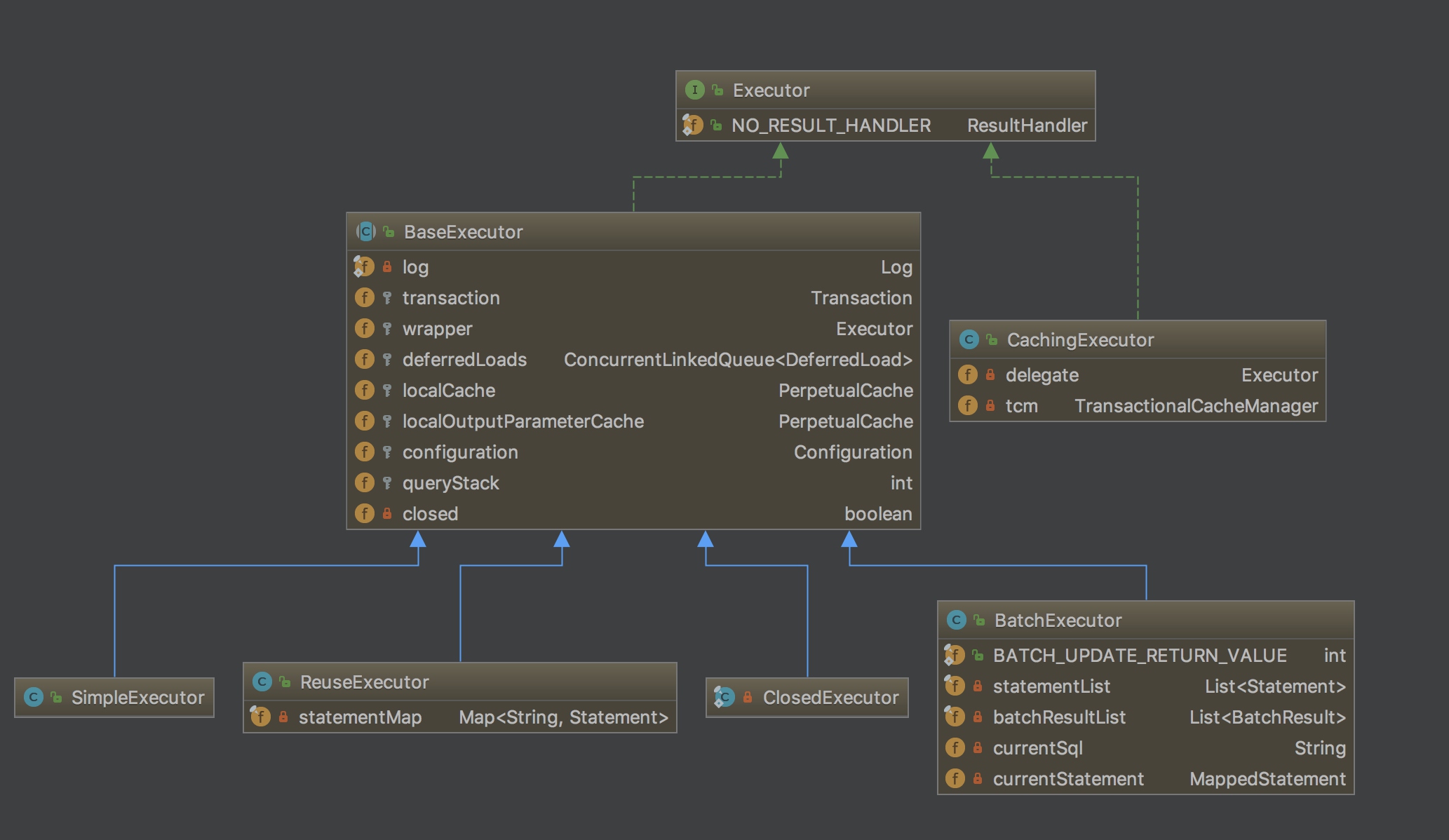
# 六、源码分析
CachingExecutor的query方法,首先会从MappedStatement中获得在配置初始化时赋予的Cache。
Cache cache = ms.getCache();
本质上是装饰器模式的使用,具体的装饰链是:
SynchronizedCache -> LoggingCache -> SerializedCache -> LruCache -> PerpetualCache。

以下是具体这些Cache实现类的介绍,他们的组合为Cache赋予了不同的能力。
SynchronizedCache:同步Cache,实现比较简单,直接使用synchronized修饰方法。
LoggingCache:日志功能,装饰类,用于记录缓存的命中率,如果开启了DEBUG模式,则会输出命中率日志。
SerializedCache:序列化功能,将值序列化后存到缓存中。该功能用于缓存返回一份实例的Copy,用于保存线程安全。
LruCache:采用了Lru算法的Cache实现,移除最近最少使用的Key/Value。
PerpetualCache: 作为为最基础的缓存类,底层实现比较简单,直接使用了HashMap。
2
3
4
5
然后是判断是否需要刷新缓存,代码如下所示:
flushCacheIfRequired(ms);
在默认的设置中SELECT语句不会刷新缓存,insert/update/delte会刷新缓存。进入该方法。代码如下所示:
private void flushCacheIfRequired(MappedStatement ms) {
Cache cache = ms.getCache();
if (cache != null && ms.isFlushCacheRequired()) {
tcm.clear(cache);
}
}
2
3
4
5
6
MyBatis的CachingExecutor持有了TransactionalCacheManager,即上述代码中的tcm。TransactionalCacheManager中持有了一个Map,代码如下所示:
private Map<Cache, TransactionalCache> transactionalCaches = new HashMap<Cache, TransactionalCache>();
这个Map保存了Cache和用TransactionalCache包装后的Cache的映射关系。
TransactionalCache实现了Cache接口,CachingExecutor会默认使用他包装初始生成的Cache,作用是如果事务提交,对缓存的操作才会生效,如果事务回滚或者不提交事务,则不对缓存产生影响。
在TransactionalCache的clear,有以下两句。清空了需要在提交时加入缓存的列表,同时设定提交时清空缓存,代码如下所示:
@Override
public void clear() {
clearOnCommit = true;
entriesToAddOnCommit.clear();
}
2
3
4
5
CachingExecutor继续往下走,ensureNoOutParams主要是用来处理存储过程的,暂时不用考虑。
if (ms.isUseCache() && resultHandler == null) {
ensureNoOutParams(ms, parameterObject, boundSql);
2
之后会尝试从tcm中获取缓存的列表。
List<E> list = (List<E>) tcm.getObject(cache, key);
在getObject方法中,会把获取值的职责一路传递,最终到PerpetualCache。如果没有查到,会把key加入Miss集合,这个主要是为了统计命中率。
Object object = delegate.getObject(key);
if (object == null) {
entriesMissedInCache.add(key);
}
2
3
4
CachingExecutor继续往下走,如果查询到数据,则调用tcm.putObject方法,往缓存中放入值。
if (list == null) {
list = delegate.<E> query(ms, parameterObject, rowBounds, resultHandler, key, boundSql);
tcm.putObject(cache, key, list); // issue #578 and #116
}
2
3
4
tcm的put方法也不是直接操作缓存,只是在把这次的数据和key放入待提交的Map中。
@Override
public void putObject(Object key, Object object) {
entriesToAddOnCommit.put(key, object);
}
2
3
4
从以上的代码分析中,我们可以明白,如果不调用commit方法的话,由于TranscationalCache的作用,并不会对二级缓存造成直接的影响。因此我们看看Sqlsession的commit方法中做了什么。代码如下所示:
@Override
public void commit(boolean force) {
try {
executor.commit(isCommitOrRollbackRequired(force));
2
3
4
因为我们使用了CachingExecutor,首先会进入CachingExecutor实现的commit方法。
@Override
public void commit(boolean required) throws SQLException {
delegate.commit(required);
tcm.commit();
}
2
3
4
5
会把具体commit的职责委托给包装的Executor。主要是看下tcm.commit(),tcm最终又会调用到TrancationalCache。
public void commit() {
if (clearOnCommit) {
delegate.clear();
}
flushPendingEntries();
reset();
}
2
3
4
5
6
7
看到这里的clearOnCommit就想起刚才TrancationalCache的clear方法设置的标志位,真正的清理Cache是放到这里来进行的。具体清理的职责委托给了包装的Cache类。之后进入flushPendingEntries方法。代码如下所示:
private void flushPendingEntries() {
for (Map.Entry<Object, Object> entry : entriesToAddOnCommit.entrySet()) {
delegate.putObject(entry.getKey(), entry.getValue());
}
................
}
2
3
4
5
6
在flushPendingEntries中,将待提交的Map进行循环处理,委托给包装的Cache类,进行putObject的操作。
后续的查询操作会重复执行这套流程。如果是insert|update|delete的话,会统一进入CachingExecutor的update方法,其中调用了这个函数,代码如下所示:
private void flushCacheIfRequired(MappedStatement ms)
在二级缓存执行流程后就会进入一级缓存的执行流程,因此不再赘述。
WARNING
MyBatis的二级缓存相对于一级缓存来说,实现了SqlSession之间缓存数据的共享,同时粒度更加的细,能够到namespace级别,通过Cache接口实现类不同的组合,对Cache的可控性也更强。
MyBatis在多表查询时,极大可能会出现脏数据,有设计上的缺陷,安全使用二级缓存的条件比较苛刻。
在分布式环境下,由于默认的MyBatis Cache实现都是基于本地的,分布式环境下必然会出现读取到脏数据,需要使用集中式缓存将MyBatis的Cache接口实现,有一定的开发成本,直接使用Redis、Memcached等分布式缓存可能成本更低,安全性也更高。